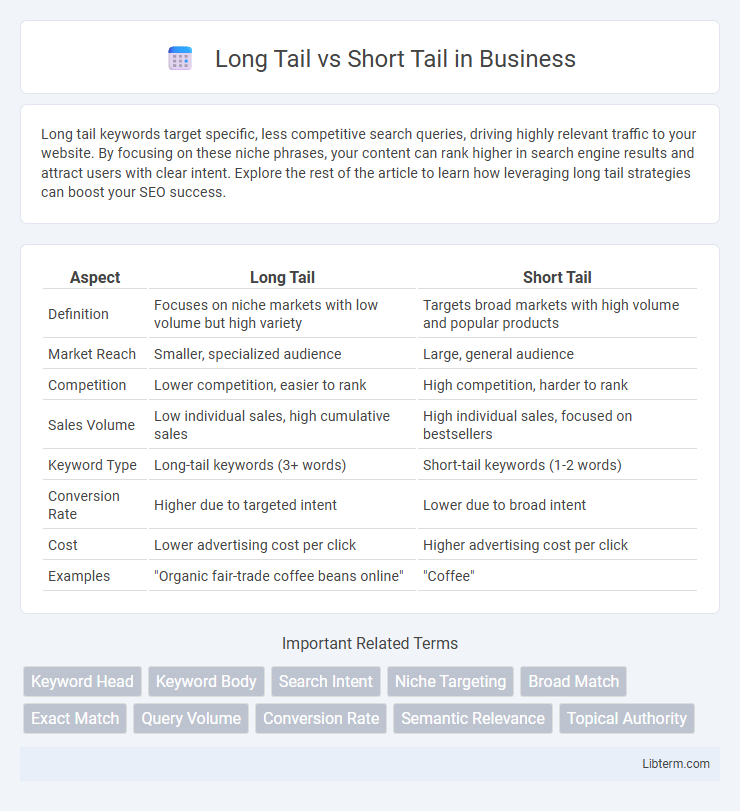Long tail keywords target specific, less competitive search queries, driving highly relevant traffic to your website. By focusing on these niche phrases, your content can rank higher in search engine results and attract users with clear intent. Explore the rest of the article to learn how leveraging long tail strategies can boost your SEO success.
Table of Comparison
| Aspect | Long Tail | Short Tail |
|---|---|---|
| Definition | Focuses on niche markets with low volume but high variety | Targets broad markets with high volume and popular products |
| Market Reach | Smaller, specialized audience | Large, general audience |
| Competition | Lower competition, easier to rank | High competition, harder to rank |
| Sales Volume | Low individual sales, high cumulative sales | High individual sales, focused on bestsellers |
| Keyword Type | Long-tail keywords (3+ words) | Short-tail keywords (1-2 words) |
| Conversion Rate | Higher due to targeted intent | Lower due to broad intent |
| Cost | Lower advertising cost per click | Higher advertising cost per click |
| Examples | "Organic fair-trade coffee beans online" | "Coffee" |
Understanding Long Tail Keywords
Long tail keywords consist of longer, more specific search phrases that typically have lower search volume but higher conversion rates compared to short tail keywords. These keywords target niche audiences and reduce competition, making it easier for websites to rank higher in search engine results. Leveraging long tail keywords enhances content relevance and attracts qualified traffic, which improves overall SEO performance and user engagement.
What Are Short Tail Keywords?
Short tail keywords are broad, generic search terms consisting of one or two words, such as "shoes" or "laptops." These keywords generate high search volume but tend to have higher competition and lower conversion rates due to their vague intent. Marketers often use short tail keywords to increase brand visibility and attract a wide audience quickly.
Key Differences Between Long Tail and Short Tail
Long tail keywords consist of longer, more specific phrases that typically have lower search volume but higher conversion rates due to targeted user intent. Short tail keywords are broader, more competitive, and generate higher search volume but often result in lower conversion rates because of their general nature. The key difference lies in search intent specificity and competition level, with long tail keywords offering niche targeting and short tail keywords providing widespread visibility.
Benefits of Using Long Tail Keywords
Long tail keywords drive highly targeted traffic by matching specific user intents, resulting in higher conversion rates compared to short tail keywords. They face less competition, making it easier for websites to rank well on search engine results pages (SERPs) and improve organic visibility. Using long tail keywords also enhances content relevance and allows businesses to capture niche markets, increasing overall ROI in digital marketing campaigns.
Advantages of Short Tail Keywords
Short tail keywords generate higher search volumes, driving significant traffic to websites quickly. Their broad scope increases brand visibility and improves overall recognition in competitive markets. They also require less content specificity, allowing marketers to target a wider audience efficiently.
Challenges of Long Tail SEO
Long Tail SEO faces challenges such as lower search volume for each keyword, making it harder to generate significant traffic quickly. It requires creating highly specific and diverse content to capture niche audiences, which can demand extensive resources and time. Tracking and measuring the effectiveness of numerous long tail keywords can complicate analytics and optimization efforts.
Short Tail Keywords: Limitations and Risks
Short tail keywords, typically consisting of one or two words, offer high search volume but face limitations such as intense competition and lower conversion rates. These broad, generic terms often fail to capture specific user intent, increasing the risk of irrelevant traffic and reduced ROI for advertisers. Relying heavily on short tail keywords can lead to wasted ad spend and difficulty in achieving targeted marketing objectives.
Best Strategies for Keyword Selection
Long tail keywords, consisting of 3 or more specific words, attract highly targeted traffic with lower competition and higher conversion rates, making them ideal for niche markets. Short tail keywords are broader, have higher search volumes, and greater competition, suitable for brand awareness and broad reach campaigns. Combining long tail and short tail strategies ensures a balanced approach, targeting both high-volume and intent-driven searches for optimal SEO performance.
When to Use Long Tail vs Short Tail
Long tail keywords are ideal for targeting niche audiences with specific search intent, often resulting in higher conversion rates and less competition. Short tail keywords work best for driving high traffic volumes and increasing brand awareness due to their broad and general nature. Use long tail keywords when targeting specialized markets or with limited budgets, while short tail keywords suit broad campaigns and high-visibility goals.
Impact on SEO: Case Studies and Results
Long tail keywords generate higher conversion rates by targeting specific search intent, as demonstrated by case studies from e-commerce sites showing a 55% increase in organic traffic and a 43% rise in sales. Short tail keywords drive larger traffic volumes but often result in lower conversion rates due to broader competition, with case studies indicating up to a 70% higher bounce rate. Combining long tail and short tail strategies yields optimal SEO performance, with results highlighting a balanced approach that improves rankings and user engagement across multiple search segments.
Long Tail Infographic

 libterm.com
libterm.com